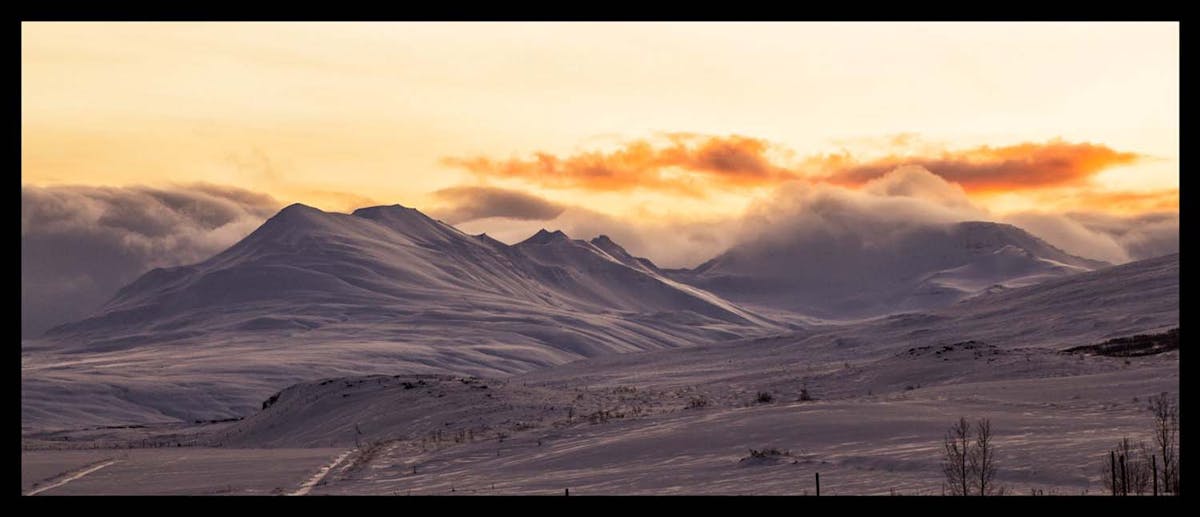The first three months were over quickly. It was a bit weird: until the end of the year, we were “only just arrived”. But by January, we started to think about when we needed to go back. The next months felt like “we are departing soon”. We planned to drive back to Keflavík via the east of Iceland, so that we had seen the rest of Route 1.
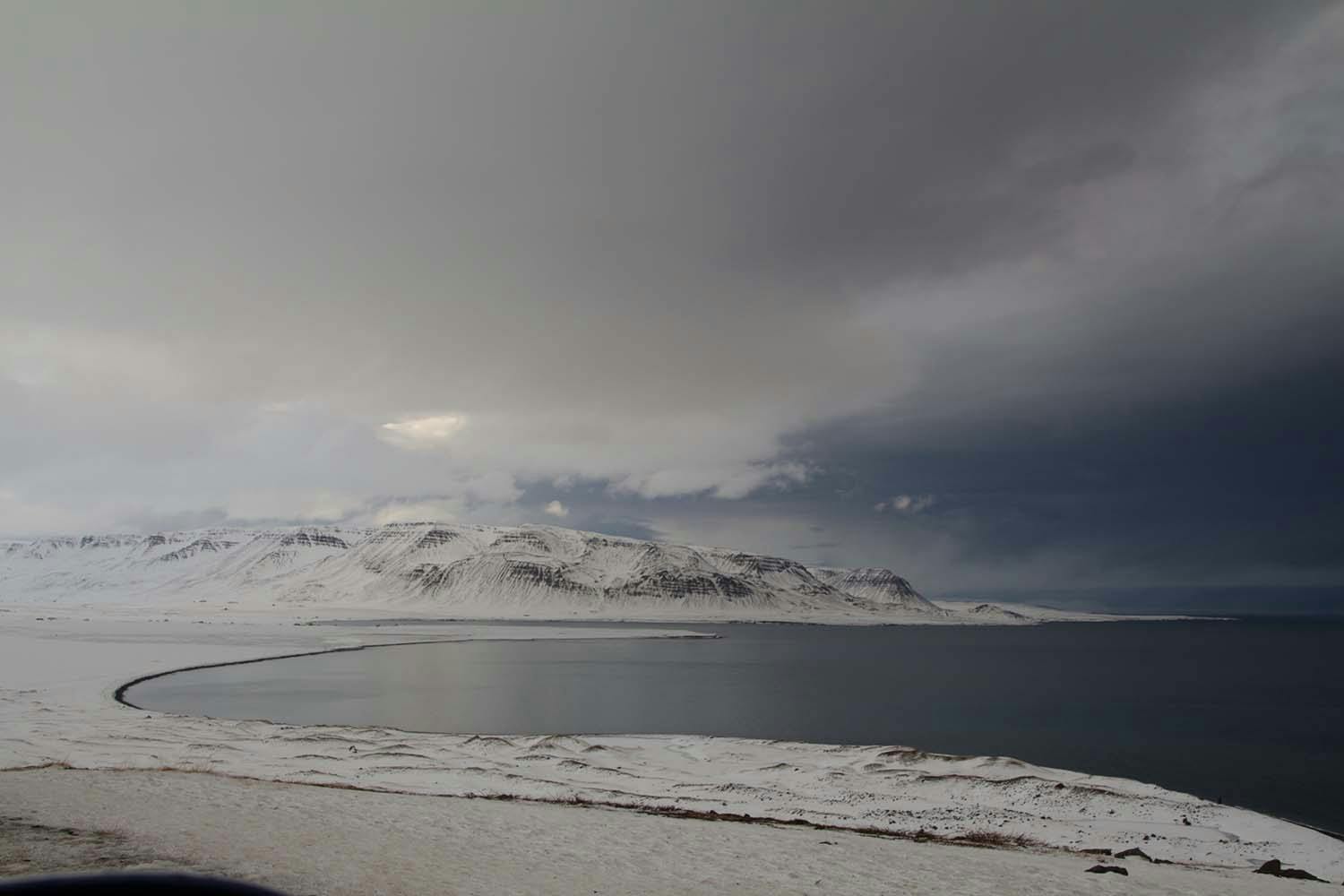
Grettislaug pool
One of the most memorable events in January was our trip to the outdoor swimming pool of Grettislaug, which is near the town of Sauðárkrókur. We left Akureyri northward, not taking the Route 1, but the smaller roads that brought us to Dalvík, Ólafsfjörður and Siglufjörður. Until the latter, the road is decent and can be driven without many problems.
After the town, the conditions are quite different. It was still the middle of January, so there was enough snow. Most of it had been cleared from the roads, but the asphalt had suffered through the ice and snow. It was patchy, full of holes and tricky spots. On one side, the road ended in a drop straight down to the sea.
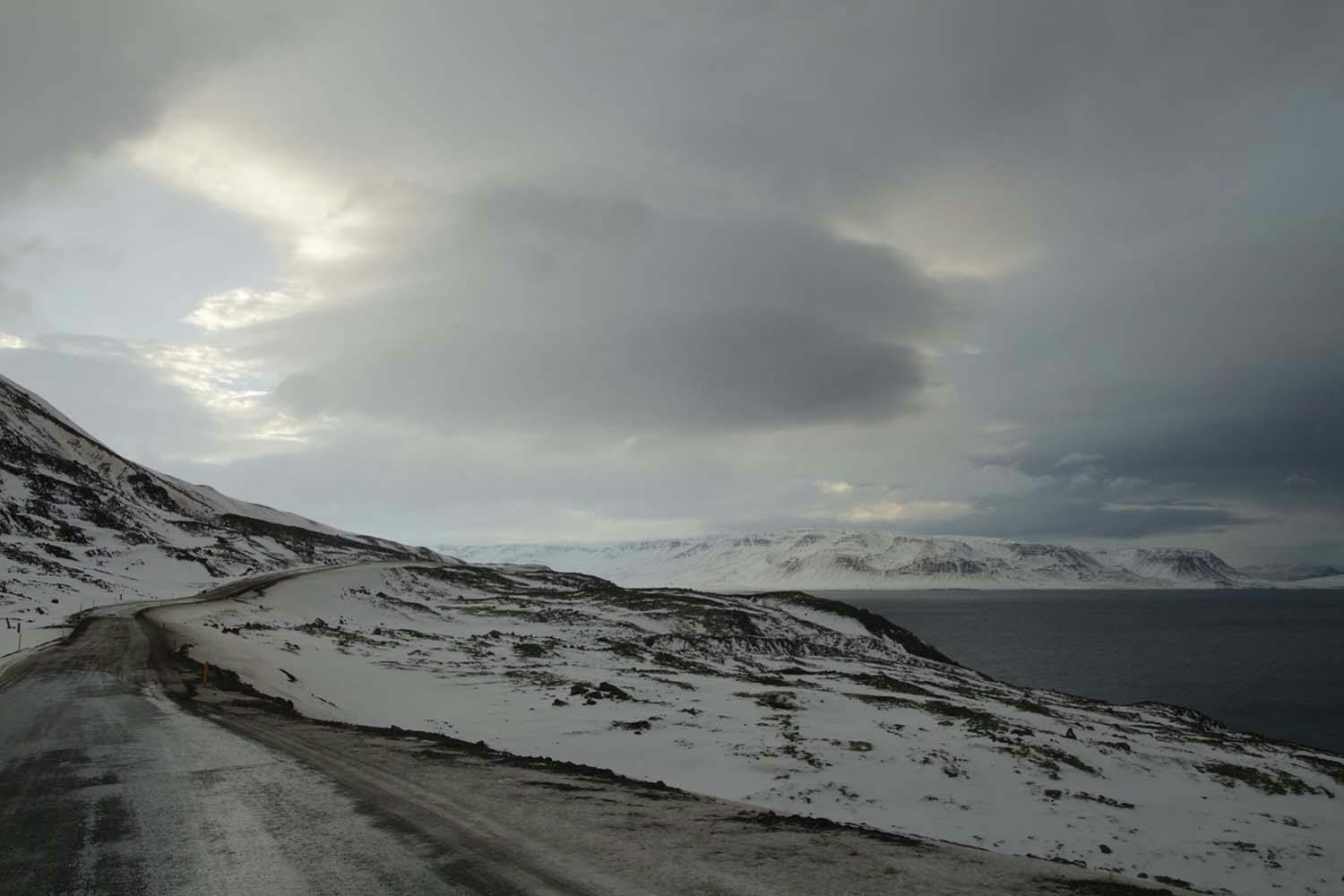
Driving up there felt like we had reached the end of the world. The Arctic Sea was grey and seemed to go on forever. The clouds made a show, breaking open here and there to admit a few sunrays.
Few people live in that area, but some horses spend the winter of the meadows out there. We had amazing views over the northern landscapes, bathed in a soft winter light. A few kilometers later, we picked up a volunteer whom we met in Akureyri. She was helping on a farm in the remote part of the so-called Tröllaskagi, caring for the horses. Because the days were still short, we continued with her to Sauðárkrókur and our ultimate destination of the Grettislaug.
From the town, we drove a road north, which got smaller and smaller until we had reached a gate. Behind the gate, the snow hadn’t been cleared, but there were car tracks… we decided to try our luck. Driving walking pace only, I steered our car, a Toyota Rav, over the snow, while the others were outside, waving and giving signs in which direction to steer. At some spots, there were barely a few centimeters of clearance between the car and the snow. If it had been any deeper, we would have gotten stuck. Although this piece of the way is only 5 kilometers, it took 20 minutes to drive. In the end, we parked the car next to a barn and walked down to the Grettislaug.
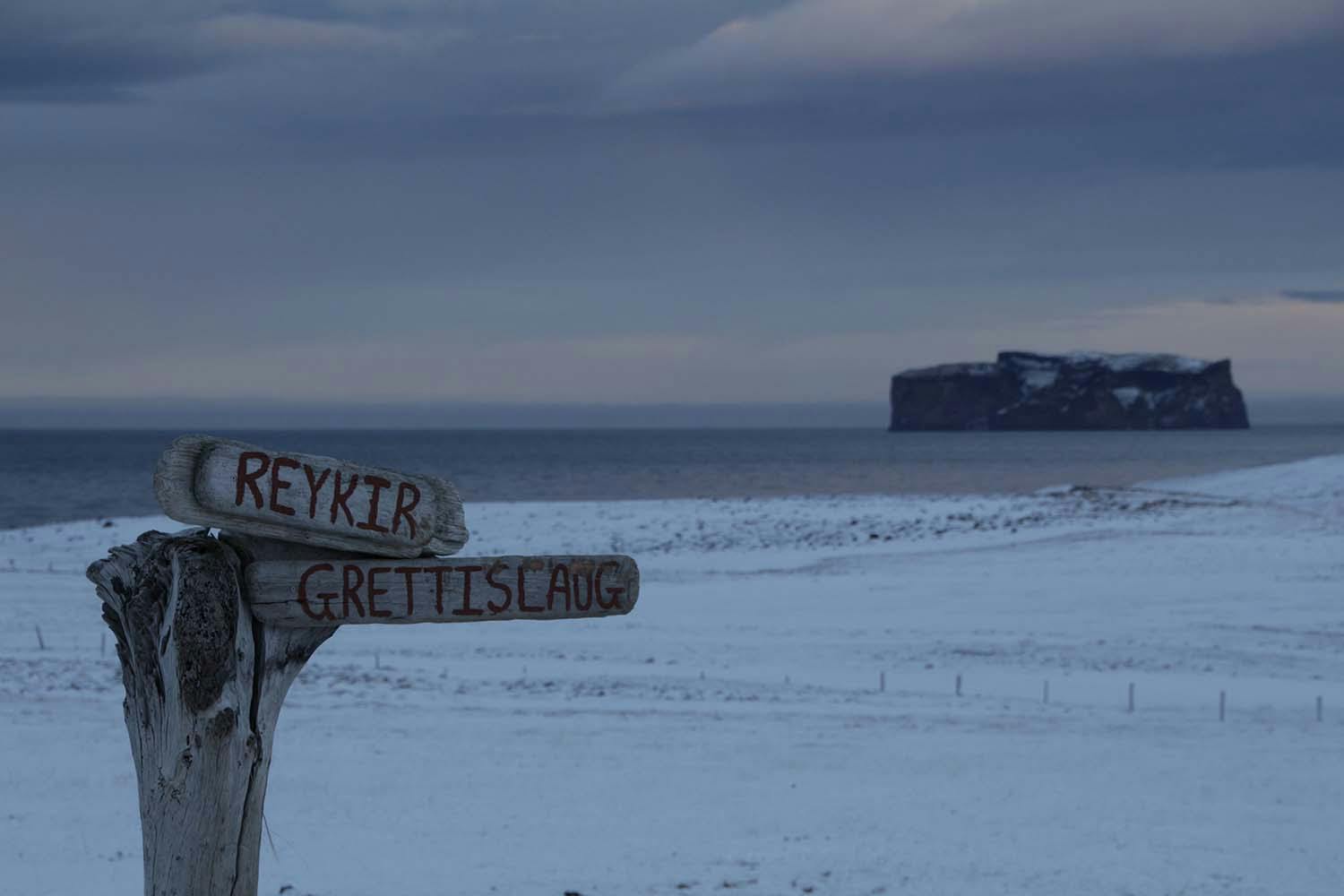
According to folklore, the pools have been there since medieval times. Grettir, who was an outlaw, decided to hide on the near island of Drangey. The island lies out in the Arctic waters some kilometers away from the location of the Grettislaug pools and it’s barely more than a rock with some birds. Grettir however, determined to stay away from the law, would warm up in the hot pools and then swim across the water to the island. Supposedly, he stayed there for some summers, going back to the land a few times to steal sheep. The pools are named in his memory. I got the feeling that the Icelandic legends are not condemning him for his crimes, there’s a lot of admiration for someone this badass.
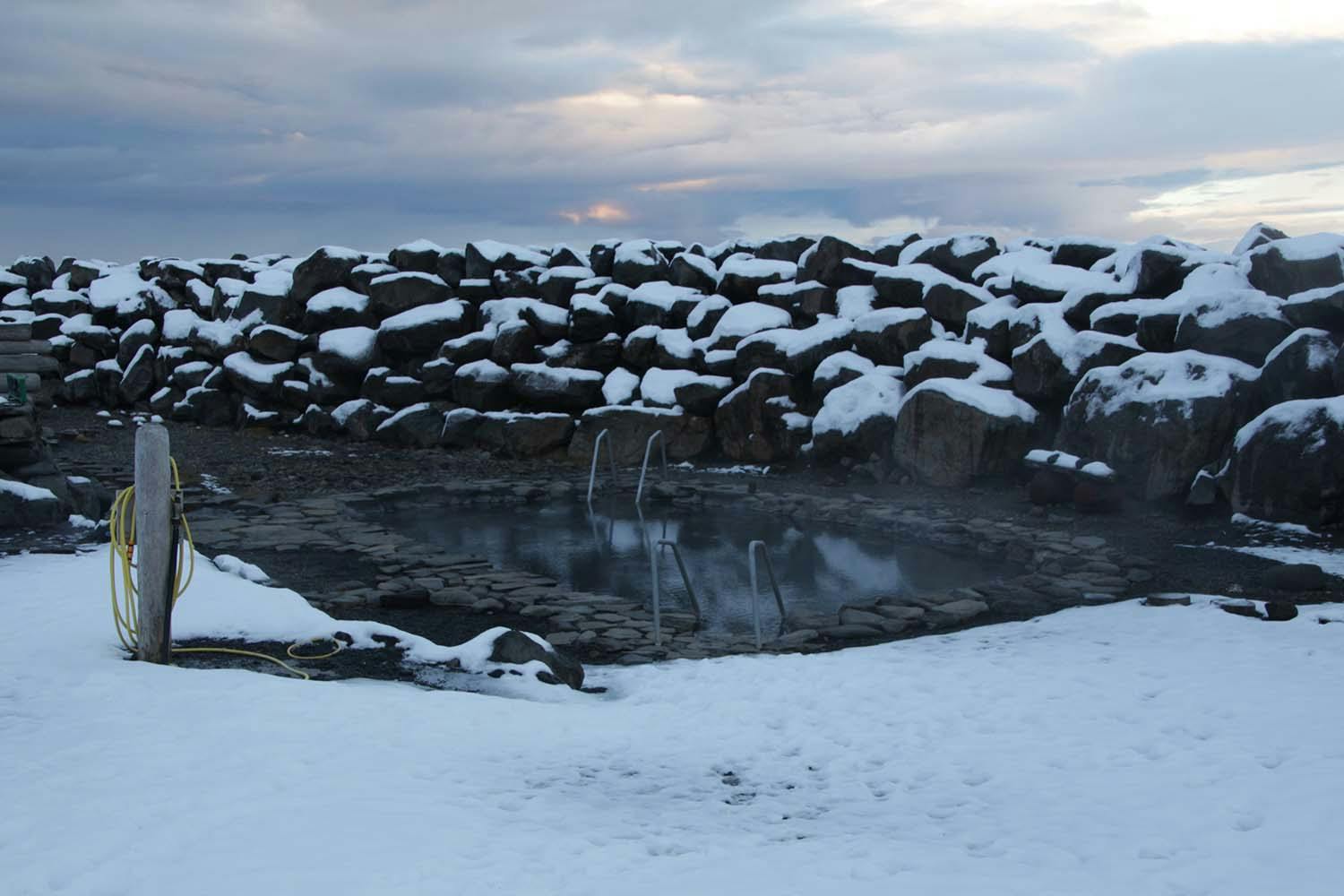
The guesthouse and the pools were deserted. We changed in the frigid air and lowered ourselves into the 40°C warm water. It was heavenly.
Out there, the atmosphere is special. It’s quiet, there are no noises, apart from the wind and the waves. The light changed constantly, painting the mountains in colors of whites, greys and blacks. You are submerged in hot water, cool and fresh air in your lungs.
The long drive had been worth it. But the adventure for the day wasn’t over yet. After we had thoroughly soaked, the noticed some other cars arriving. One of them father and son (Icelanders), the others Americans who were scouting for wedding locations in the summer. While the son showed them around, we talked to the father (in Icelandic), and he wanted to sell us some of his horses. We politely declined, got changed again and started home.
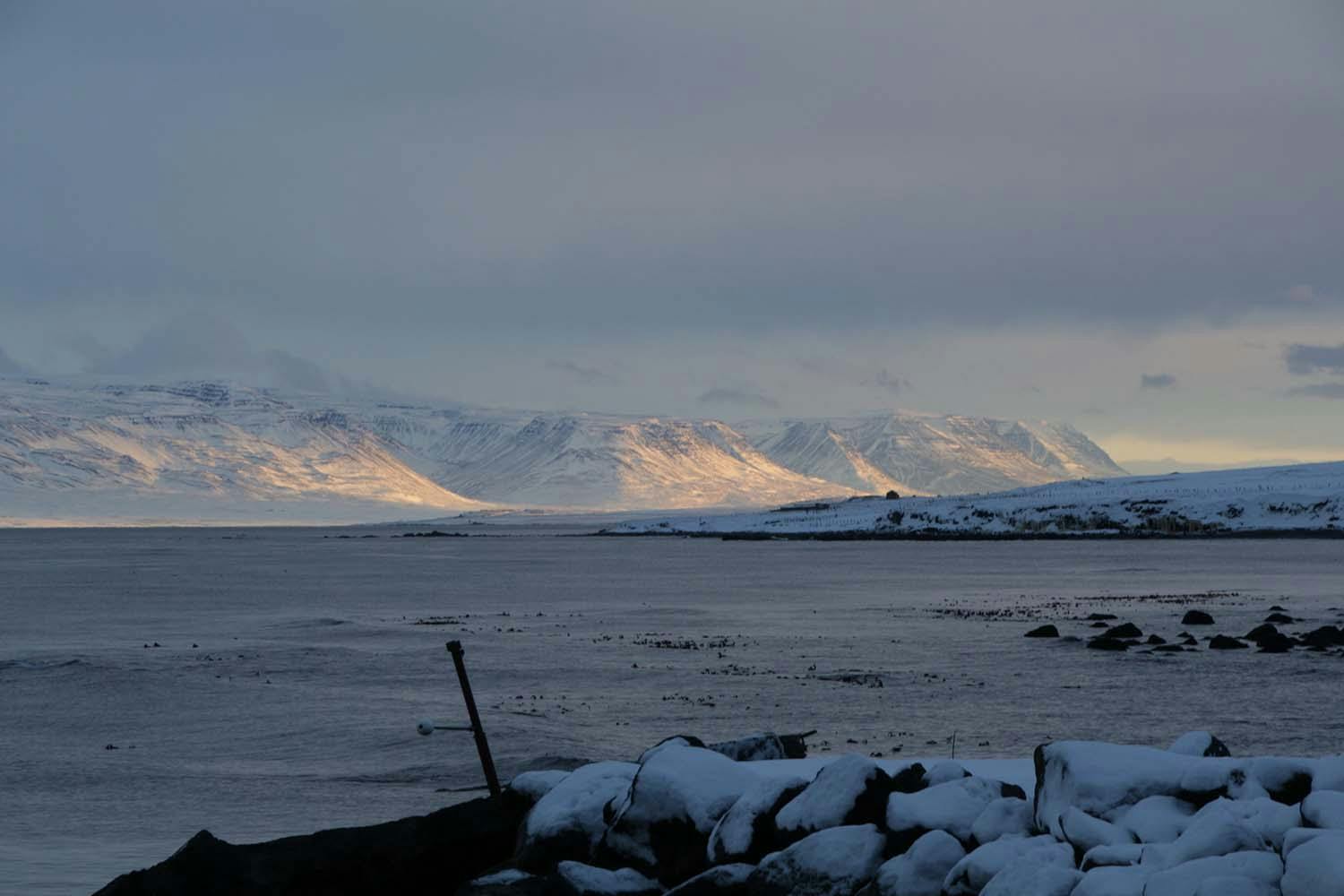
We stopped at a gas station to get some hot coffee (really cheap and decent quality), but for some reason, we didn’t fill up the gas. Barely 30 kilometers later, the gas indicator needle dropped into the red area. It continued to go down, finally coming to rest at “empty” some 10 kilometers away from the farm where our friend stayed. We hoped that it would last — they would surely have some gasoline, or at least be able to help us acquire some.
Bravely, the Toyota drove on. We dropped off our friend and asked the family. The mother told us that there was a station just another 3 kilometers away and it would be the best spot. We started the car again, went back to the main road. Fueled mainly by our hopes, the car actually drove the last kilometers. The “station” turned out to be a huge tank and a gas pump, not a single soul in sight.
It accepted electronic cash and we were able to fill the car up. In the meantime, it had gotten dark and we still had almost 100 kilometers left to go, back over the rickety roads towards Siglufjörður and then down to Akureyri. We arrived exhausted, happy and a little wiser.
Lesson learned: always fill up your car in Iceland, even if you think you won’t need it. The country will offer truly stunning experiences, at the same time, you need to take care in your travels.
Northern Lights aka Aurora Borealis aka Norðurljós
As I mentioned in the beginning, the first months we often postponed activities, because “surely there would be time later”. While we enjoyed watching the northern lights with some regularity, we hadn’t taken many pictures yet. When our trip home was just a few weeks in the future, we decided that we should photograph the northern lights now, because there might not be another chance.
Eventually we had fantastic northern lights and my girlfriend was out in the snow (and cold) taking pictures, while I was in bed with a headache. The key to great northern lights pictures is longer exposures, up to minutes at a time. For this, the camera should be as fixed as possible, only possible with a sturdy tripod. It’s also important to get the lights into focus, which requires some tinkering and experimentation.
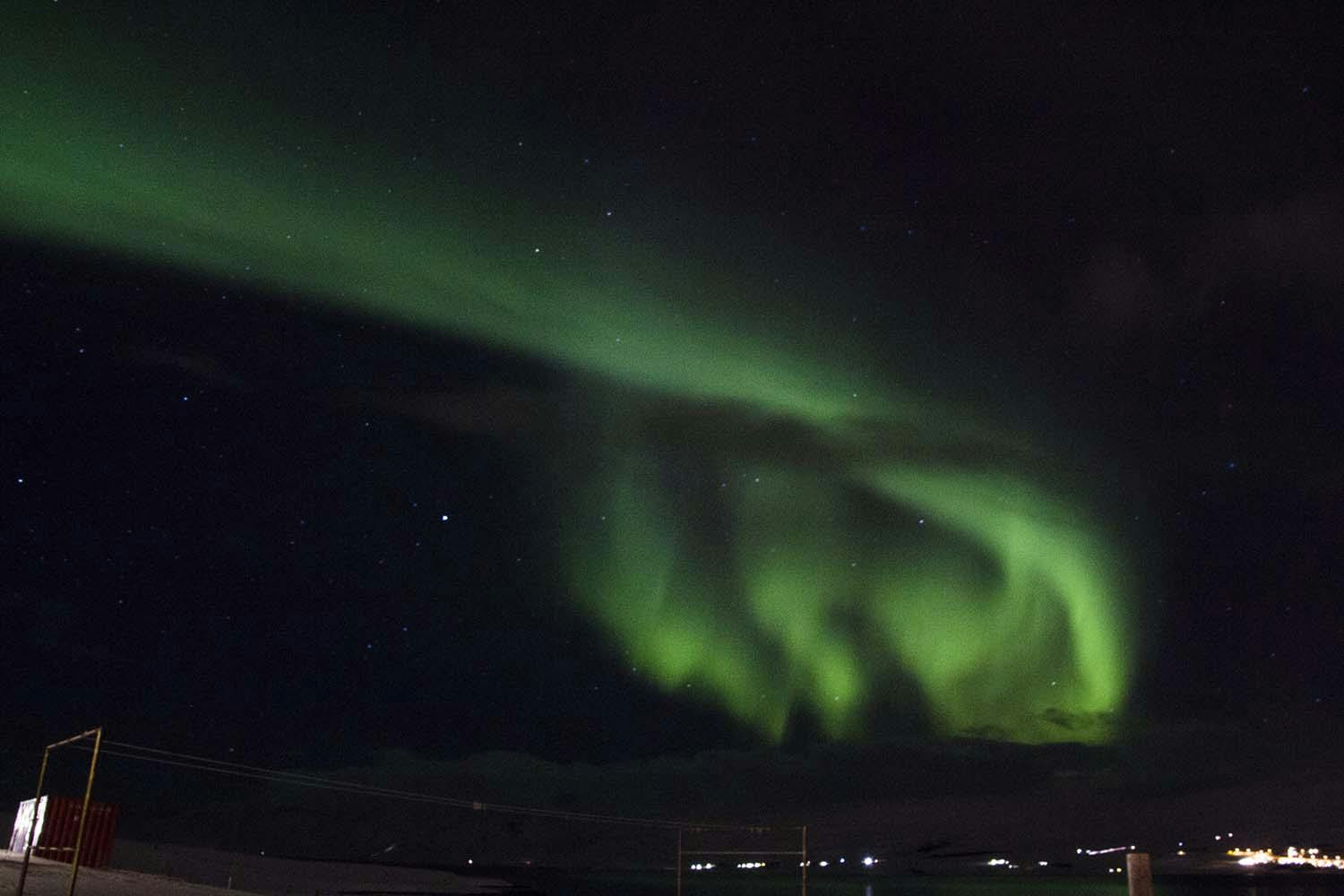
Ugly Food Festival
InJanuary and February, it’s Icelandic custom to hold a food festival called Þorrablót. Up in the north, it’s a community event held in a gym hall. All citizens are invited: in the municipality where the guesthouse is there are only enough people to fill the gym comfortably, around 600. Everything was decorated and a stage was set up.
Because alcohol is rather expensive and you need a special license to sell it, everyone was allowed to bring their own beer, wine and Brennivín (hard liquor) to the festival.
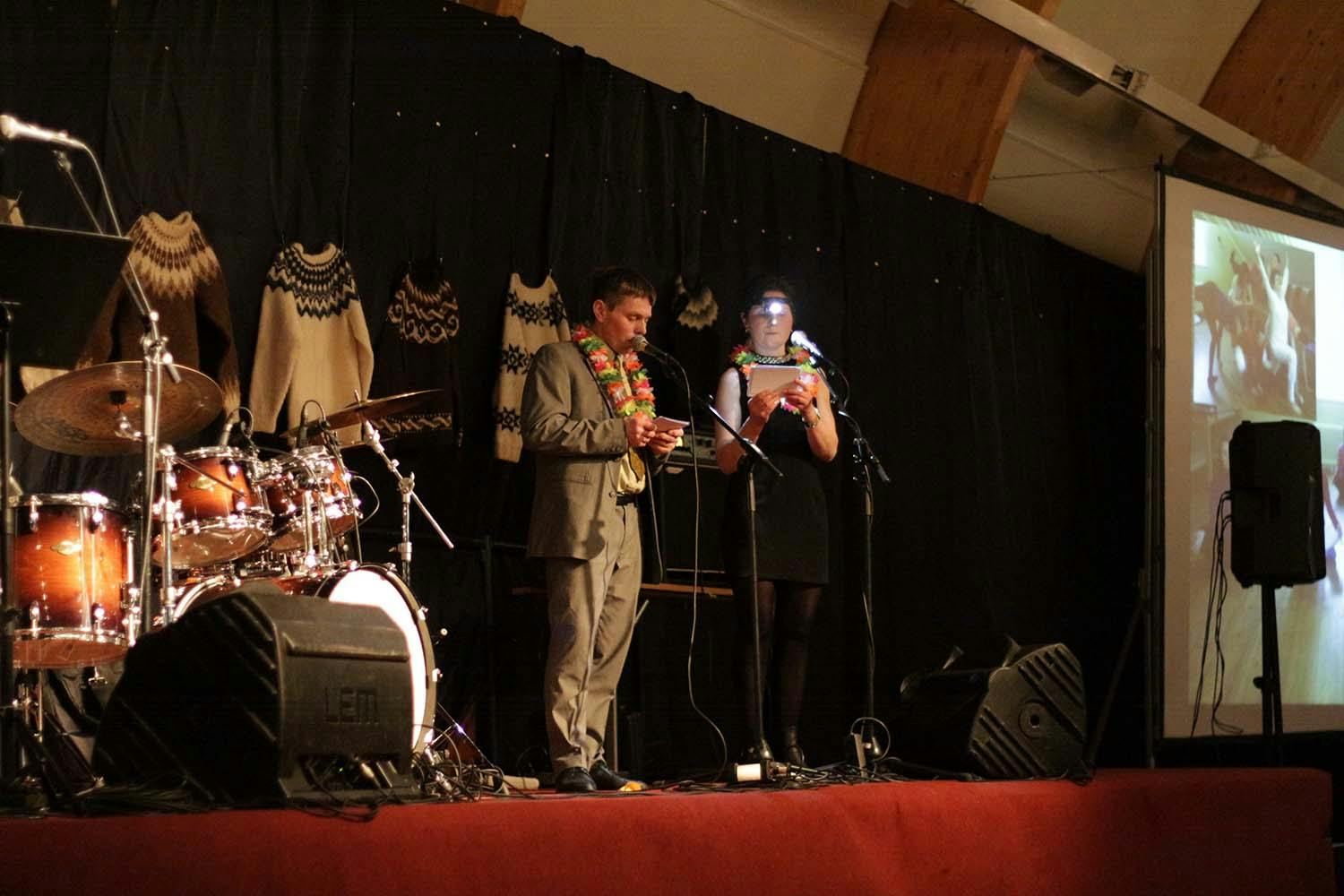
It started off with a welcoming speech and a little toast, then came the food. Part of the event is the so-called Þorramatur, a serving of traditional “specialties” of the Icelandic cuisine. It’s not for the queasy and it’s definitely not for vegetarians. The food is served as a buffet, so at least you have a chance to try as little as possible.
The actually edible and tasty portion consisted of smoked mutton (Hangikjöt), dried fish and horse sausage, plus the “basics” of bread and potatoes. More exotic was cured whale (Súr Hvalur, tasted like decade old kitchen sponges), ram’s testicles, sheep’s head (can either be served whole or in aspic) and hákarl (fermented shark that smells like ammonia).
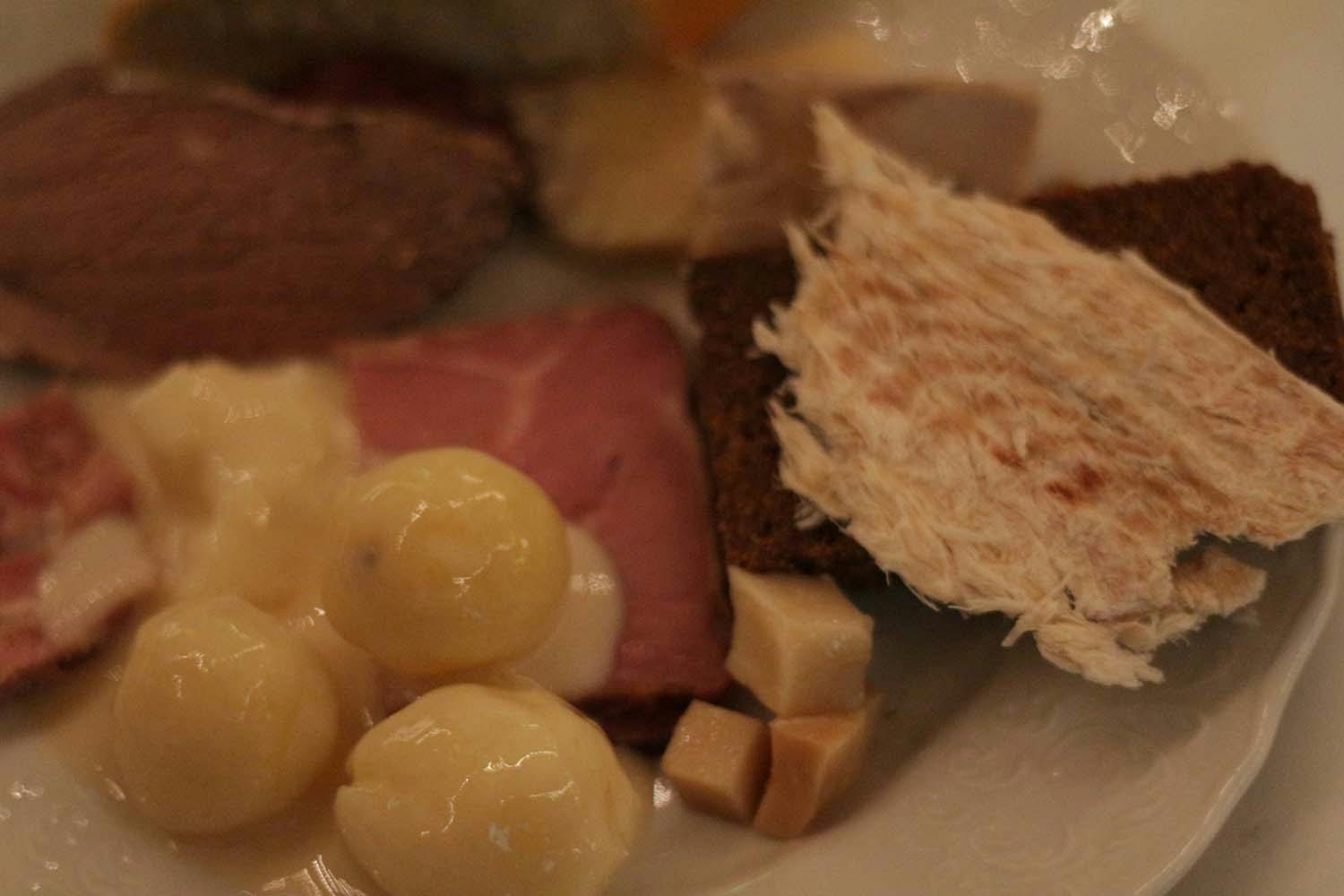
We tasted everything, some things had to be washed down in copious amounts of beer.
As the evening and the drinking went on, the mood lifted and everyone was in good spirits. After the food was cleared away, the show began. First there were some speeches and songs, but sadly we understood next to nothing. Next up were some home-made movies about events from the last year. The community made these in good humor to mock their neighbors and their ideas, ranging from GPS-controlled sheep to rumors of sado-maso sex dungeons. All these short clips made the people roar with laughter and even though we couldn’t understand much of the Icelandic, the movies were hilarious by themselves.
A band started to play and a dance commenced until late at night. We all had a great time experiencing local culture away from what you normally see as a tourist.
Winter waterfalls
InFebruary, we went on a snowshoe hike at the Dettifoss waterfall. Unfortunately, the road to the waterfall is snowed in during the winter. The tour however, was conducted out of Akureyri with a “super jeep”, a jeep with large balloon tires that are able to just drive over the snow without getting stuck.
The tour guide drove us over past the Mývatn lake together with three other people who were on the same tour, explaining some details on the way. He then just drove off the street, past the signs put up by the road authority, declaring the road closed. Behind the sign, driving in a normal car would be impossible. Navigating by long poles sticking out of the wood, we reached the parking lot (also snowed in), took a sharp right — and got stuck in a snowdrift. Luckily, another super jeep tour was also out there, so our guide had the truck towed out by one of his competitors… it surely scratched his ego a bit.
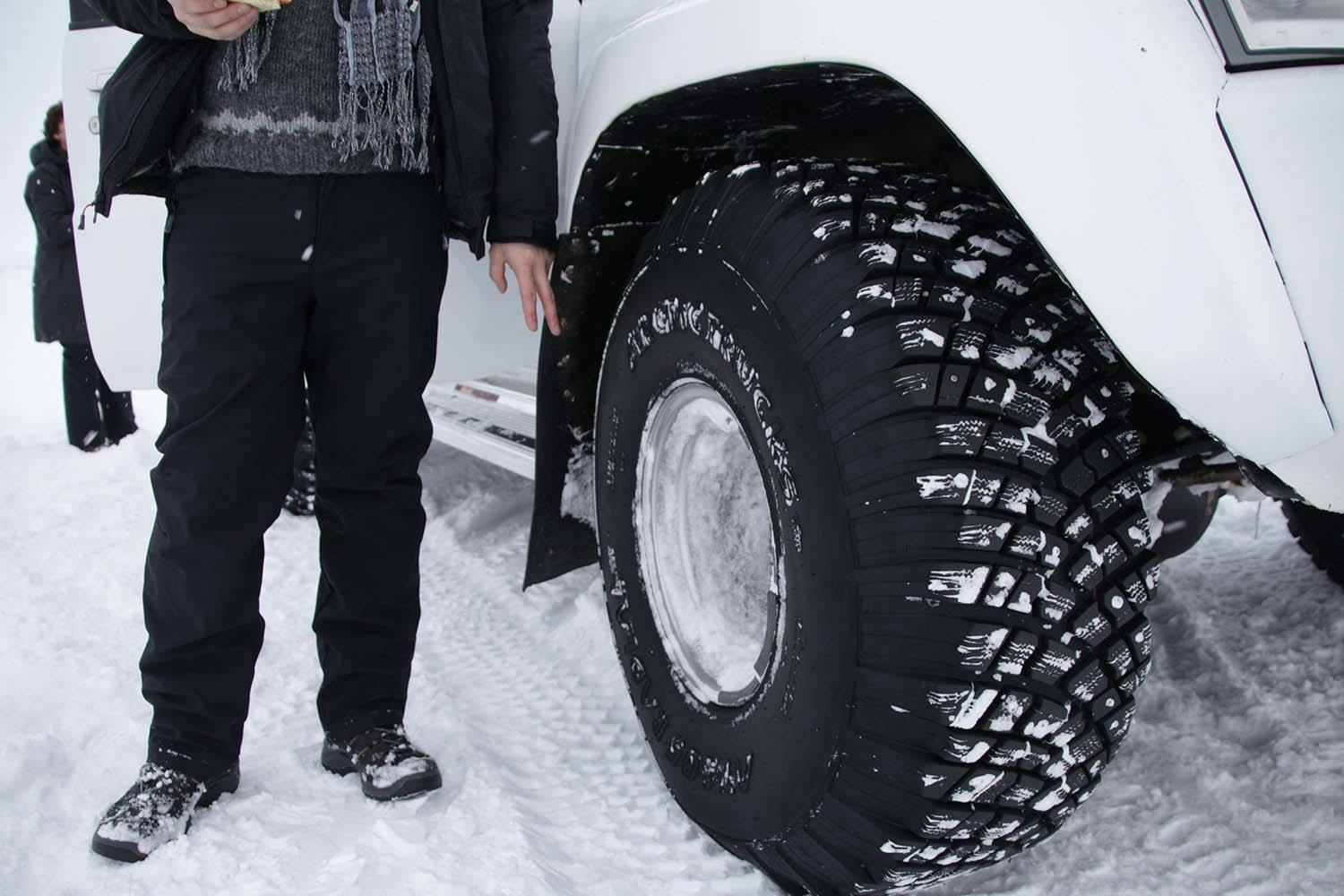
Having the truck secured, we left on snowshoes towards the Dettifoss waterfall. Here, the water drops 45 meters with an enormous roar. As the water splashes, it forms icicles and ice shapes all around. We took pictures and the tour went on to another waterfall some hundred meters away. The river connecting these falls runs through a canyon, ice drifting lazily on top between the black stone walls.
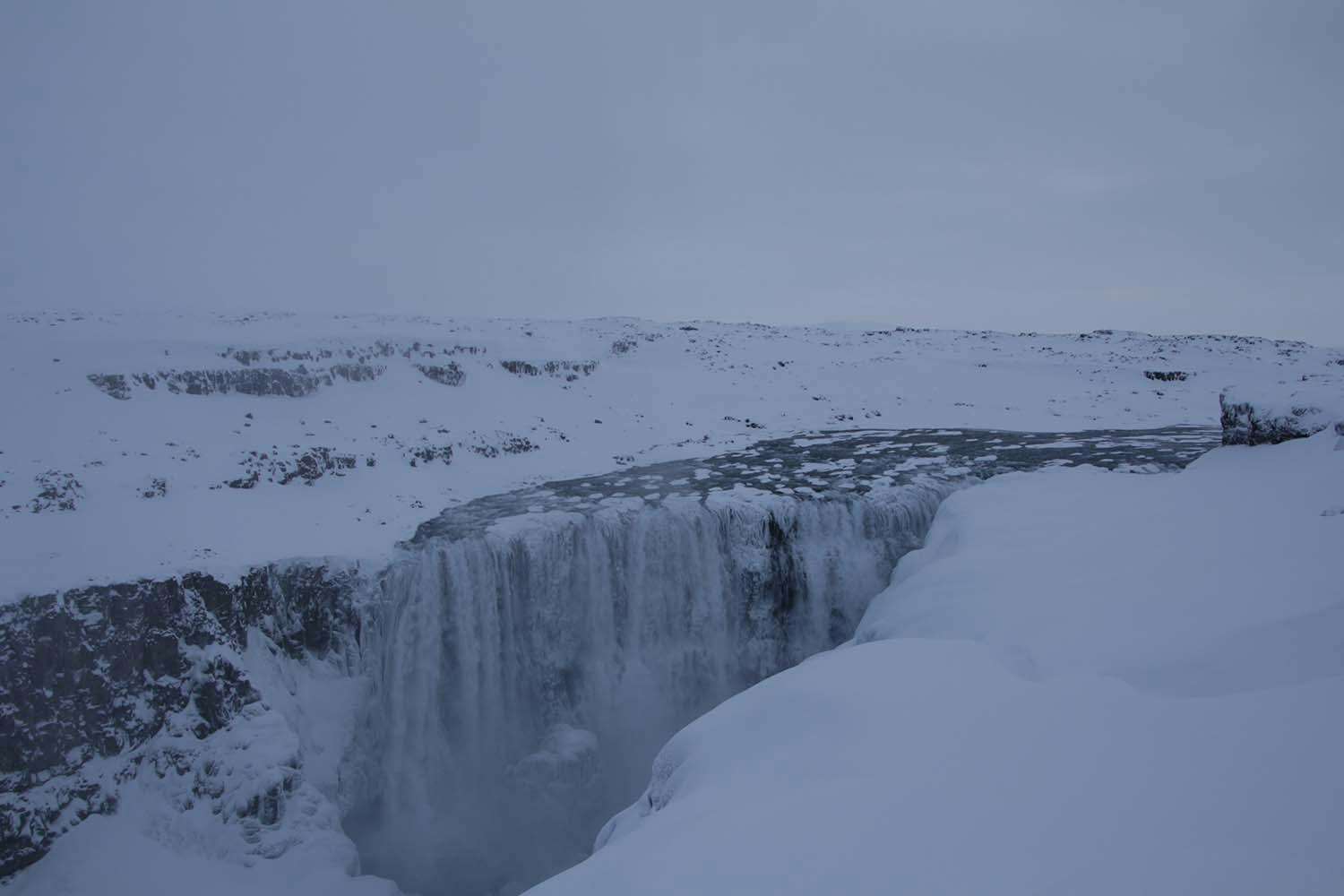
It was wintery Iceland at its best: snow, water, stone and the forces of nature, far away from any living soul. The next permanent settlement was at least 25 kilometers away.
On the way back, right at the “Do not enter sign”, we encountered some tourist from Asia in a small BMW coupé. They stopped the tour guide and asked if they could also go down the road we just came from. He told them that they would get stuck with a regular car after about 5 meters and had to be pulled out. The tourist didn’t seem to be very happy about this and asked about a way going in the highlands to see the Askja volcanic area. Again, our driver told him that’s not possible, due to the snow and the closing of some roads. I’m not sure where the tourists went next, hopefully they made their way home safe.
We often saw cars stuck in the snow, all over the winter months and it happens even to Icelanders. It’s no big deal if you are in a somewhat populated area and you have a way to contact someone to help you. In remote regions, no one might come that way for a whole day and we often heard stories about foreigners being stuck on tricky roads for hours, until they were found.
This is not limited to winter though, for instance the road that the Asian man asked about (to the Askja mountain area) is suitable for 4-wheel drive only, even in the summer. At some point, you might have to drive through a river, something which I wouldn’t attempt on my own. Out there in the highlands, cellphone coverage isn’t guaranteed and heading out carelessly might lead to serious consequences.
…and then?
We prepared to fly home in March and started to research what we might do afterwards. We had both quit our jobs in two different cities and all opportunities were open. We wanted some place to stay for a while, some sort of solid job and an apartment that was bigger than the 8 square meters we had in the guesthouse.
It’s daunting to be able to go anywhere: studying in Sweden? Working for a large company in northern Germany? Travel to Canada? I applied at Lego two or three times, but wasn’t able to get in, and I wanted to build some ideas I had developed with a friend back in Germany. My girlfriend looked for jobs all around Europe. Applying from another country wasn’t too easy, we couldn’t just fly in for interviews and we had some long talks on where to go.
In the end, we decided to move back to my family for a few weeks and look for jobs in and around Munich. In hindsight, we should have stayed a bit longer, enjoyed the end of the winter. But once our flights back were booked, we allowed for some days to travel around the east and see the rest of the country. I’ll tell you more about that in the next article.
